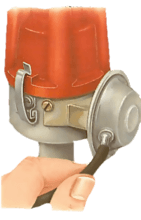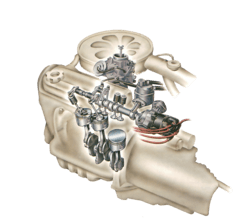Stroboscope

Checking the ignition while the engine is idling can be done with a stroboscopic lamp, or timing light, which is clipped between the sparkplug used for timing and its lead. The head is directed at the engine timing marks, and each time the plug sparks, the lamp lights up the timing marks so that you can check whether the spark accurs at the specified setting before top dead centre.
A neon timing light, which relies solely on the HT voltage, is often sufficient as long as the timing marks are accentuated (with white paint, say) and the work is carried out in a shaded place. More expensive timing lights, such as Xenon-tube lamps, are powered from the battery or mains as well, and give a brighter light. An induction-type strobe light can be clipped to the plug lead without disconnecting it.
A stroboscope, also known as a strobe, is an instrument used to make a cyclically moving object appear to be slow-moving, or stationary. The principle is used for the study of rotating, reciprocating, oscillating or vibrating objects. Machine parts and vibrating strings are common examples.
Intense flashing/pulsing light of various frequencies can trigger epileptic seizures in people who suffer from photosensitive epilepsy.
Read more on Wikipedia
Cet outil est utilisé dans
A static timing check with the engine stationary is never fully accurate. It does not allow for ...
Running-on is when the engine continues to turn after you've switched off the ignition because th...


